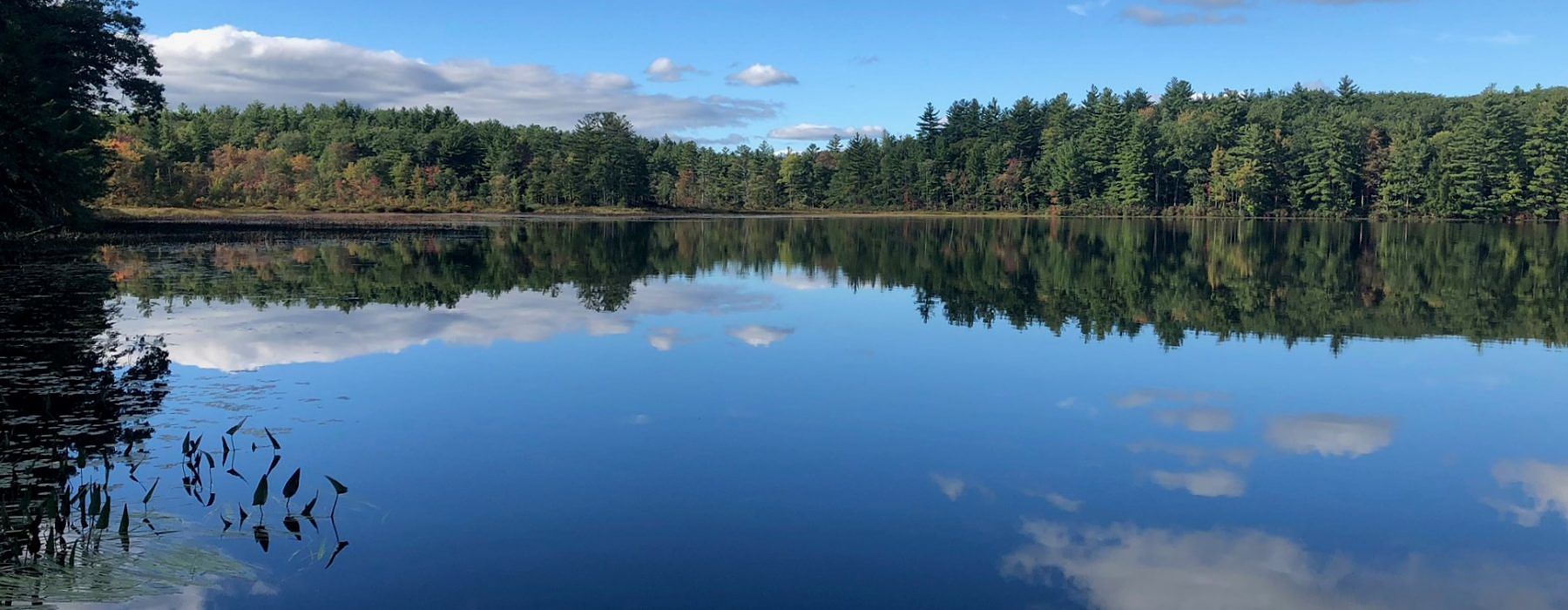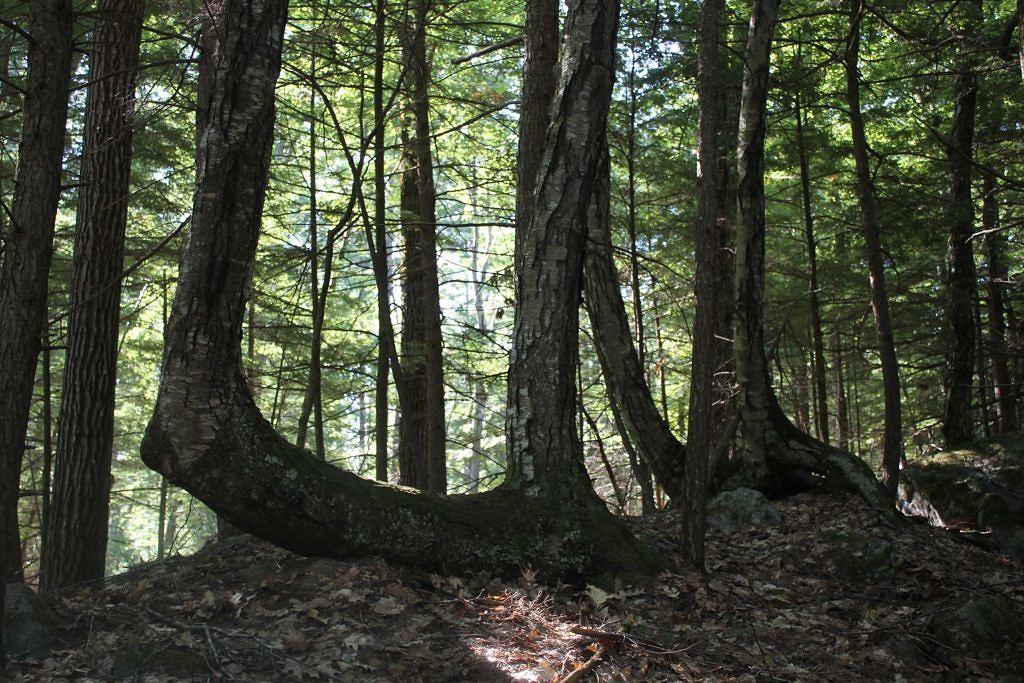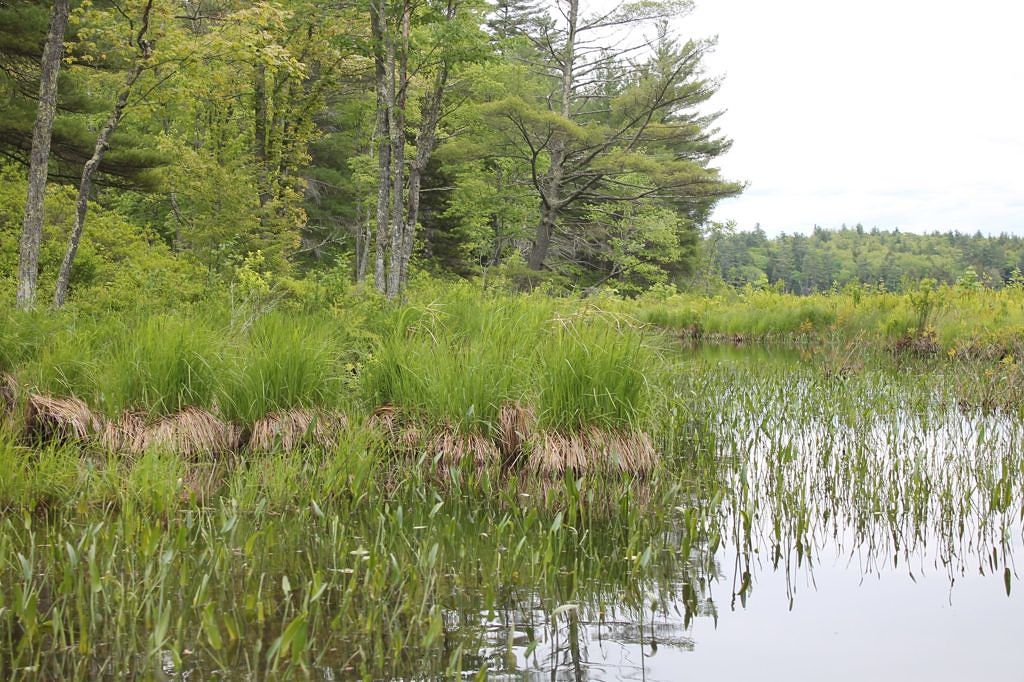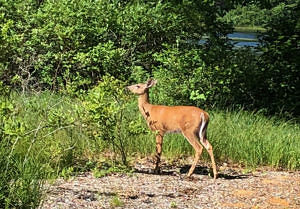
Ecology
An important facet of Graylag’s mission is protecting and preserving the ecology of the forests, soils, and waters of the nature preserve and its watershed.
To ensure the land’s protection from future development in perpetuity, Bear-Paw Regional Greenways, a local land trust, holds a conservation easement on most of Graylag’s land. The goals of that easement include protecting Graylag’s productive forests, undeveloped lake frontage, wildlife habitat, and quality of groundwater and surface water.

Forests
Most of Graylag’s 300+ acres is forest. Our stewardship of that forest is guided by the understanding that to maintain the health and integrity of the landscape, it is important to understand its ecological setting beyond its legal property boundaries. Our forest management plan, developed in 2016 by Dalton Mountain Forestry, examines the property within its larger ecological context and identifies forest management techniques to support the forest health, wildlife habitat, water quality, and recreational access.
In the fall and winter of 2019-2020, we conducted a logging operation based on this management plan. This logging operation supported the health of the forest and provided revenue for Graylag Nature Preserve’s operations and ongoing conservation efforts, as well as lumber for our new barn.
Broad Vegetation Zones
Hemlock-Hardwood-Pine Forest
Hemlock-hardwood-pine is the dominant forest type in the region that includes Graylag. Hemlock-hardwood-pine forest is the most widely distributed forest type in New Hampshire, covering nearly 50% of the state’s land area (approximately 15% is permanently protected). The typical tree species in this type of forest are Eastern hemlock, American beech, red oak, red maple, and white pine. The greatest threats to hemlock-hardwood-oak pine forest are human development, introduced species, and altered natural disturbance (NHFG 2006).
The forest stands dominated by hemlock or white pine support low plant diversity in the understory and on the forest floor. Plants associated with these stands include witch hazel, winterberry, and wild sarsaparilla. Stands with a mix of hemlock and hardwoods or hemlock-hardwood-white pine support a greater diversity of understory and ground flora as well as associated wildlife species.
Upland Forests and Blueberry Barrens
The tree species diversity on Graylag is relatively low. The dominant species being hemlock, red maple, white pine with some red oak, American beech, white ash, and a small mix of other species including white and black birch. In most areas the understory vegetation and ground cover is also quite sparse. The upland areas with the greatest diversity are those within riparian areas around the wetlands and water bodies. The understory and forest floor vegetation in the upland forests varies depending on soils, slope, and disturbance and in places includes highbush blueberry, lowbush blueberry, hay-scented and New York ferns, Canada mayflower, winterberry, starflower, partridgeberry, among other species.
Early Successional Habitat
Early successional habitats–grasslands, shrublands, young forests–are declining in the northeast, a result of forest maturation, lack of natural disturbance, and loss of habitat to development. The region experienced a surge of early successional habitat and associated wildlife species following the clearing and then abandonment of farmland in the 1800s and early 1900s. So, the decline of wildlife species dependent on early successional habitat is not surprising as forests reclaim the landscape. Retaining and creating patches of early successional habitat within the forested landscape is seen as important to maintaining the range of biological diversity native to this region. The area cleared by the Tornado of 2008 presents an opportunity to create a swatch of early successional habitat at Graylag.
Lowbush Blueberry Barrens and Borrow Pit
Graylag has been releasing highbush and lowbush blueberries to enhance berry production for wildlife and humans. These actions have been particularly successful around the borrow pit along the gravel access road in the southern region of the Property. Patches of lowbush blueberry are growing in the understory within the vicinity of the borrow pit. The conditions seem ideally suited here to continue the release of lowbush blueberries.
Disturbances
The forested landscape on Graylag and elsewhere in southeastern New Hampshire has experienced a variety of disturbance histories. Natural disturbances of these forests largely come from singletree wind throw, with occasional larger blow downs from hurricanes. Beaver are also an important natural disturbance dynamic in wetland systems. These forests have evolved for thousands of years with these natural disturbances. More “recent” disturbances include farming and farm abandonment, human settlements, logging, recreation, and introduced forest pathogens.
2008 Tornado
A sudden and dramatic windstorm (later confirmed as a tornado) moved rapidly through southeastern New Hampshire on July 24th leaving behind a 50-mile long narrow swath of snapped and downed trees and damaged houses. Graylag was in the path of this severe storm that impacted approximately 33 acres of the Property, although the impact was patchy within this swath. Almost all the standing trees in this swath were snapped off or flattened, many with roots still attached.

Water
Adapted from “Land Stewardship Plan for Graylag” by Ellen Snyder, Ibis Wildlife Consulting, August 2008.
Graylag has a series of vernal pools, headwater streams, and wet meadow/shrub wetlands embedded within a hemlock-hardwood-pine forest nestled on the shores of Wild Goose Pond. The various wetlands at Graylag support a rich biological diversity. The upland forests, by contrast, are less rich biologically, in part because of past land uses that include logging and land disturbance.
Freshwater Wetlands and Water Bodies
Freshwater wetlands are grouped into several general categories in New Hampshire: open water-emergent wetlands, scrub-shrub wetlands, forested wetlands, peatlands, and vernal pools. Emergent wetlands are marshes with a mix of open water, floating-leaved vegetation, and herbaceous growth in standing water. Shrubs such as highbush blueberry, maleberry, speckled alder, winterberry, and nannyberry, and a few saplings of red maple or other trees typically dominate scrub-shrub wetlands. Forested wetlands are often associated with slow-moving streams and beaver flowages and support trees, particularly red maple. Peatlands are a wetland type with low nutrient content and higher acidity caused by limited groundwater input and surface runoff. Vernal pools are ephemeral wetlands that dry up sometime during the year.
Graylag supports vernal pools, scrub-shrub wetlands, wet meadow, and open water-emergent wetlands. In addition to these wetlands, the Property supports perennial and intermittent streams that flow into Wild Goose Pond. These wetlands and water bodies are the least disturbed natural communities on the Graylag property and should be considered as areas sensitive to disturbance.
Wild Goose Pond and Shoreland
Graylag has more than one-quarter mile of frontage along Wild Goose Pond. A relatively small area in the central portion of this frontage includes a beach, canoe/kayak storage, and dock used by visitors to the nature preserve. The pond frontage to the northwest of the beach is in a relatively natural condition and includes emergent plants such as pickerelweed, yellow pond lily, white water lily, water shield, and pondweed. Shoreland vegetation includes red maple, speckled alder, winterberry, arrowwood, royal fern, and buttonbush. To the south of the beach the land rises steeply to a hemlock-hardwood forest.
The open water habitat of Wild Goose Pond supports common loon, mallard, Canada goose, great-blue heron, beaver, otter, largemouth bass, chain pickerel, brown bullhead, bluegill, green frog, red-spotted newt, among other species. In summer, the vegetated riparian area along the pond shore supports song sparrow, swamp sparrow, cedar waxwing, American goldfinch, common yellowthroat, yellow warbler, Baltimore oriole, red-winged blackbird, tree swallow, Eastern kingbird, Eastern phoebe, and common grackle.
Wet Meadow/Cranberry Bog
A unique wet meadow community is located near the shores of Wild Goose Pond to the north of the developed beach/cabin area. This plant community is part of the larger wetland complex that forms the inlet and outlet to the Pond. The wet meadow was used as a baseball field when Camp Graylag owned the property. Considering how wet the area is today it is difficult to understand how the fields were kept dry and mowed. The nearby stream that flows into Shinglemill Brook appears channeled near the edge of the wet meadow, so perhaps they used some drainage system to dry out the “field.”
An old basketball court is located at the edge of the wet meadow; other courts were removed several years ago using a WHIP grant.
Highbush blueberry shrubs are growing in around the edges of and scattered throughout the wet meadow. Small cranberry, sedges, rushes, mosses, and other plants are found within this meadow. With time and lack of further disturbance, this wet meadow may recover to a more diverse and unique plant community. Wet meadows, along with marsh and shrub wetlands, are considered critical habitats in the New Hampshire Wildlife Action Plan.
Scrub-Shrub Wetland
A diverse mixed tall graminoid-scrub shrub marsh is located in the southwest corner of Graylag. The wetland plant community includes red maple, gray birch, highbush blueberry, winterberry, maleberry, Spirea, royal fern, cinnamon fern, pitcher plant, buttonbush, speckled alder, sphagnum, among other plants. The vegetation in the uplands along the marsh edge is also diverse and includes highbush blueberry, lowbush blueberry, bracken, sheep laurel, bunchberry, Canada mayflower, partridgeberry, trailing arbutus, starflower, lichens, mosses as well as red maple, white pine, hemlock, and red oak. The forest rises steeply along the northeast boundary of the marsh and supports a hemlock-white pine forest with some red spruce.
Vernal Pools
Vernal pools are ephemeral wetlands that fill in spring from rainfall, snowmelt, or rising groundwater. (Watch a video explorations of one of Graylag’s vernal pools here.) Some pools also fill in the fall after autumnal rains. These pools are typically small in size, ranging from less than 1/10th acre to more than 2 acres. Size, however, is not always an indicator of the quality or productivity of a vernal pool. Most vernal pools completely dry out by the end of summer and therefore can not support fish populations, which makes these pools safe for breeding amphibians.
The length of time that a pool retains water is known as its “hydroperiod.” Most vernal pool breeders need about four months to complete their reproductive cycle. Pools that retain water for longer periods are also important, especially in drought years, when some pools may dry up too soon. Vernal pools vary in the animals that are present, yet most are characterized by the presence of at least one “indicator” species, one that depends on vernal pool habitat for successful reproduction. Vernal pool indicator species include fairy shrimp (small crustaceans), wood frog, spotted salamander, and blue-spotted and Jefferson salamanders. Smaller organisms such as bacteria, fungi, zooplankton (e.g., daphnia), caddisfly and other insect larvae, crustaceans and insects are all food for the larger vertebrates within these vernal pools.
Vernal pools embedded within the forested landscape are important “stepping stones” for many wildlife species as they move about in search of food and breeding sites. Foraging turtles (including wood and Blanding’s), raccoon, mink, deer and other mammals, herons, and other wildlife also use vernal pools. Wood frogs and spotted salamanders travel to vernal pools in the spring to breed, and then spend the rest of the year (11+ months) in the uplands, typically within 1,000 feet of the pool. Juvenile wood frogs may travel farther. A researcher in Massachusetts found the biomass of vernal pool amphibians to be greater than the biomass of all the birds and mammals combined in the upland forest surrounding his study pool. Clearly, these habitats and associated wildlife are key biological elements of the forested landscape. Maintaining suitable upland habitat conditions around vernal pools is as important as protecting the pools from disturbance. Canopy shade, deep leaf litter, and fallen trees and stumps are all important.
Graylag has several vernal pools of varying sizes and plant composition. Highbush blueberry and winterberry are the common shrubs associated with the vernal pools. Spotted salamander and wood frog egg masses have been observed in most of the vernal pools. In the dry season, these vernal pools are often only noticeable in the forest as small depressions with compacted leaves or dark waterstains.
Shinglemill Brook and Other Headwater Streams
Graylag has 1,200 feet of frontage on both sides of Shinglemill Brook, a main tributary (inlet) to Wild Goose Pond. Shinglemill Brook enters onto the northern corner of the Property and roughly parallels the boundary before leaving the Property along its northeast boundary after which it flows into Wild Goose Pond. The tornado swath crossed Shinglemill Brook and changed the riparian conditions in the northern section of the Property.
Several other perennial and intermittent streams flow through Graylag. A perennial stream flows out of the scrub-shrub wetland and flows northeast through the Property, flowing under the Graylag driveway and into Wild Goose Pond near the inlet. A smaller intermittent stream also flows northwest into Wild Goose Pond and is located in the southeast corner of Graylag.
The health of larger rivers and streams is dependent on the health of these smaller streams and wetlands farther up in the headwaters of a watershed. These small headwater streams may make up 80 percent of the stream network in a region and include both seasonal and year-round streams. Headwater streams may begin as trickles, seeps, or depressions that overflow and are often not named or mapped. Yet, the quality and integrity of these headwater streams is critical to downstream habitats.
The upper reaches of the watershed store water, recharge groundwater, and reduce the intensity and frequency of floods. Small streams are a critical link between land and water. Not only are they linked to upstream and downstream portions of the watershed, but water flowing from the land into the stream carries insects, leaves, soil, branches, and other material that are the start of a food chain. This exchange between land and water occurs in a transition zone along the edges of stream channels, called a riparian area. Maintaining connectivity between stream channels, stream bottoms and banks, and the riparian area is important to protect water quality and aquatic habitats. Much of the cleansing action and nutrient cycling in a stream occurs in saturated sediments, at the interface between stream water and the channel bottom and stream bank.
Herbaceous plants found along Shinglemill Brook and the other streams on the Property include false hellebore, New York fern, cinnamon fern, royal fern, marsh fern, sphagnum, and goldthread.

Adapted from “Land Stewardship Plan for Graylag” by Ellen Snyder, Ibis Wildlife Consulting, August 2008.
Wildlife abounds at Graylag, which is home to animals including deer, moose, opossums, porcupines, skunks, woodchucks, coyotes, bobcats, chipmunks, squirrels, beaver, otters, snakes, frogs, newts, turtles, and many species of birds, fish, and insects.
Graylag lies within a several thousand-acre relatively unfragmented block of habitat. However, most of this is not permanently protected and is vulnerable to fragmentation through development. Retaining this large block of unfragmented habitat is critical to many wide-ranging species in the region such as northern goshawk, fisher, otter, black bear, moose, and bobcat.
Certain ecological features support the biodiversity of wildlife at Graylag. Some of these features include:
Tree Cavities
Graylag has cavity trees scattered throughout, although the number of such trees is limited in some areas, particularly the large sizes. Some of the wildlife species that utilize tree cavities found on Graylag include:
Black-capped chickadee, downy woodpecker, tufted titmouse, hairy woodpecker, red-breasted nuthatch, white-breasted hatch, brown creeper, great-crested flycatcher, pileated woodpecker, eastern chipmunk, gray squirrel, red squirrel, porcupine, fisher, and racoon.
Some species require large trees for nesting. These include broad-winged hawk and northern goshawk, which could nest on the Property. Typically these large woodland hawks require large trees with three- pronged branching where they can build a large stick nest. Yellow birch and other hardwoods often support this branching pattern.
Dead and Down Woody Debris
Dead and down woody debris (often called “coarse woody debris”) on the forest floor is important for many reasons. Decaying wood supports many insects and other invertebrates, which are food sources for shrews, woodpeckers, and black bears. Snakes, fisher, and weasels hunt among the woody debris.
Many species including mice, voles, salamanders, snakes, chipmunks, red squirrels, weasels, and black bear use coarse woody debris for cover, den sites, or escape areas. The winter wren nests in upturned tree roots. Turtles, mink, otter, and waterfowl bask on this wood and fish find cover in woody debris.
Forest Stands
Hardwood dominated forest stands on Graylag support the following wildlife species: overbird, red-eyed vireo, scarlet tanager, mourning dove, Eastern wood pewee, tufted titmouse, black-and-white warbler, white- breasted nuthatch, great-crested flycatcher, blue jay, black-capped chickadee, black-throated-blue warbler, and Eastern chipmunk.
Mixed forest stands (a balance of hardwoods and softwoods) support these wildlife species: pine warbler, veery, hermit thrush, blue-headed vireo, red-breasted nuthatch, yellow-bellied sapsucker, black-throated-green warbler, brown creeper, pileated woodpecker. The immature red-eft stage of the red-spotted newt is abundant in the moist understory of the Property’s mixed wood and softwood stands.

Geology
The rocks of Graylag have a fascinating story to tell as silent witnesses of events whose scale in space and in time can scarcely be imagined. Viewed in the light of basic geological background information, they become virtual pages in a textbook of geological events and processes over a vast span of time.
At each of Graylag’s exposed bedrock ledges the effects of Pleistocene or Ice Age glaciation are clearly evident, with major rock surfaces having been smoothed almost to a polished state by the sandpapering action of debris embedded in the ice. Many of these surfaces also show gouges or striations produced by larger pebbles frozen into the icy glacial mass.
Some geological features that may be of interest to visitors include:
Veins of quartz: seen in many of the bedrock outcrops at Graylag.
Schistosity or foliation: a feature characteristic of schist, the predominant bedrock type at Graylag.
Pegmatite: an unusually coarse-grained form of granite in which large individual crystals or grains of common (and sometimes uncommon) minerals prevail.
Glacial smoothing and glacial striations: seen in a number of outcrops along the drive.
Drag folds: a miniature form of great mountain-building folds of distorted bedrock layers that are produced under great heat and pressure deep within the earth.
The text above is excerpted from a report prepared in September 2019 by Ron Kley, of Museum Research Associates.
